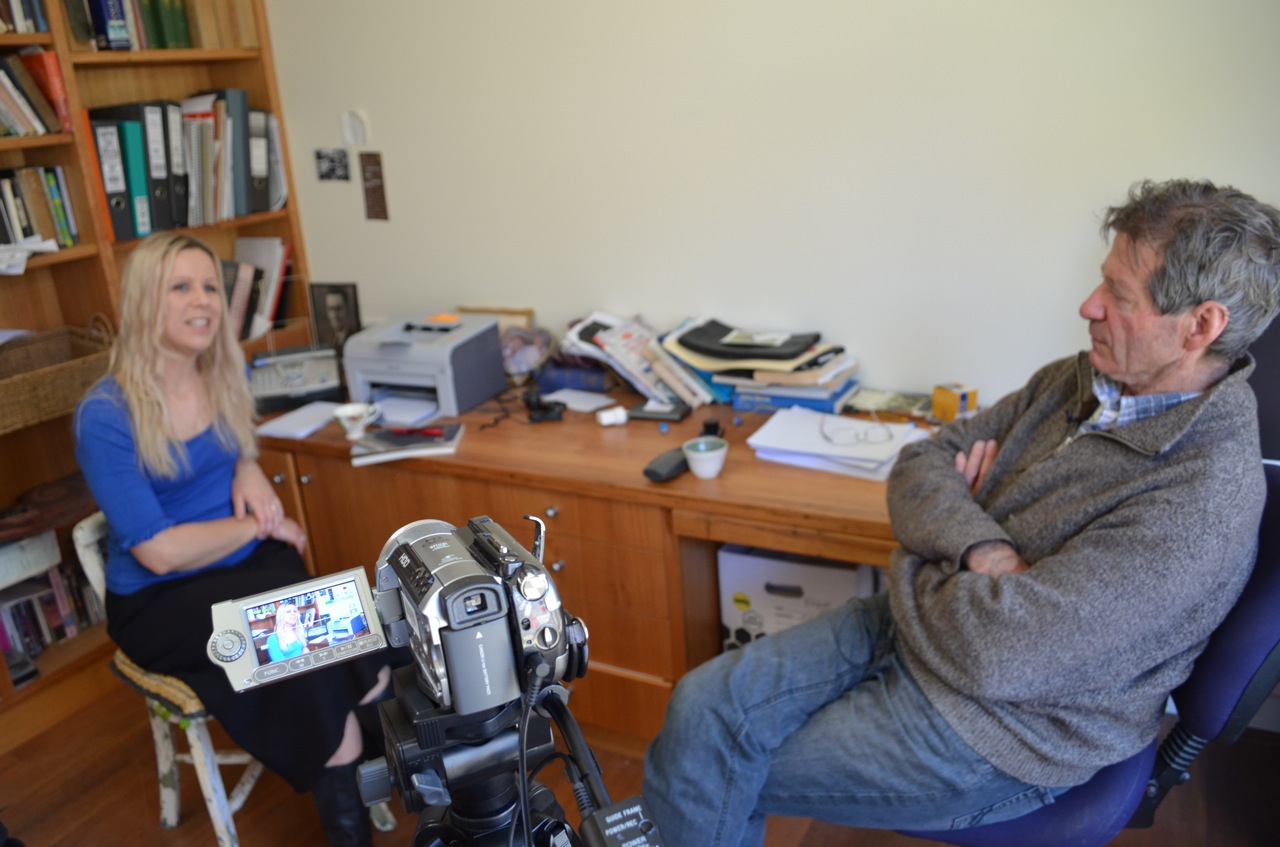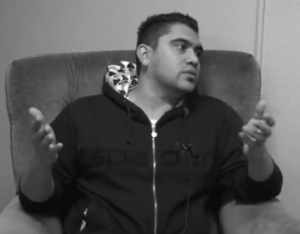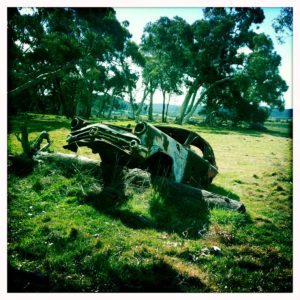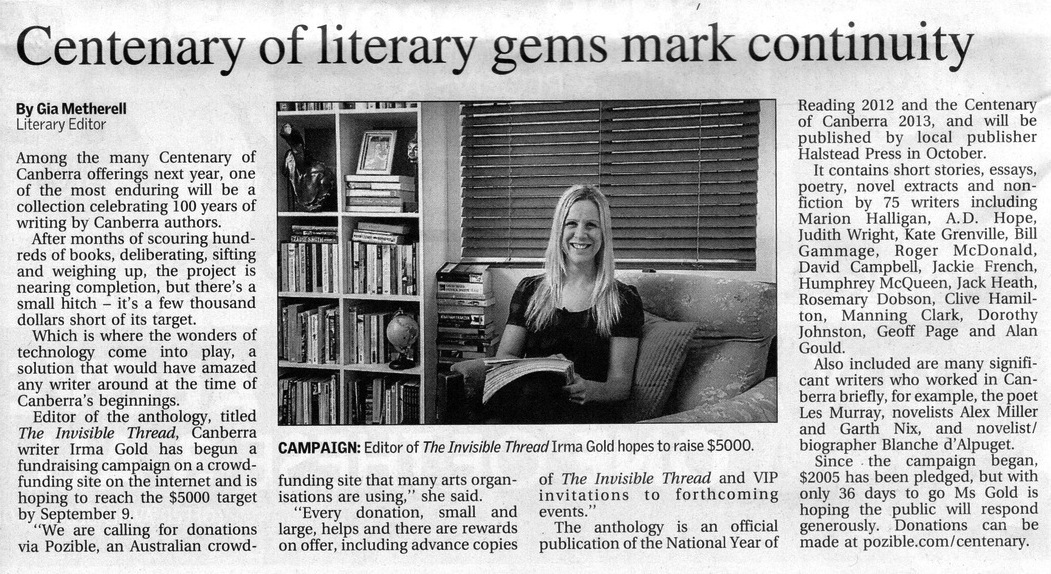On a searing blue-sky day my cameraman, Dylan, picks me up and we road trip to Roger McDonald’s home, just outside Braidwood. When we hit dirt roads we follow Roger’s concise instructions with landmarks that include sulky wheels and stock ramps. The landscape is like something out of a novel, a Roger McDonald novel perhaps. There is half a rusted car, a group of Clydesdale horses, and a pair of cows standing in the middle of the road who watch us approaching with disinterest.
I have just finished telling Dylan that I don’t think I could live in the middle of the bush, and then we come upon Roger’s home. I immediately take it back. It is stunning, a building my architect brother would surely admire. Later Roger points me to a passage in his 1996 novel The Slap where he prophesied a ‘hand built’ house with ‘rammed earth walls and ironbark slabs, a wide verandah of stringybark poles and an atrium of heavy glass saved intact from the demolition of the original Hatton Holdings building, bought for a song in Sydney’.
Stepping out of the car, Roger is already outside to greet us. Down the hill a little way a pile of wood is flaming. ‘It’s the last day we can burn anything,’ Roger tells me. ‘We’ve been chopping down some of the trees nearest the house.’ We stand side by side looking out at the landscape, the frogs chirruping. There’s something about the place. Its stillness instantly lulls me.
Read More »The Invisible Thread series: Roger McDonald
Inside I decide I’ve definitely found my dream home (care to swap, Roger?). There’s a collection of teapots on the kitchen counter, covetable art on the walls, and floor-to-ceiling glass doors and windows looking out across the hills. Roger tells me that at night the only lights to be seen are fifteen kilometres away. The view inspired one of my favourite lines in When Colts Ran: ‘On the main highway fifteen kilometres away cars have their headlights on, so far off that as the minutes pass their lights go piling into each other in a continuous animated pulp of diamonds.’
The house is made up of three separate buildings and we walk to the second where Roger’s office is. While he makes tea a cat creeps out from the adjoining study where his wife works. I reach down to stroke her but he warns me she’s a face scratcher. ‘Oh,’ I say, retracting. ‘But she’s very beautiful.’ ‘You can think that,’ he replies. ‘I’m not a cat person myself.’
 Dylan sets up the cameras in Roger’s writing space. The window frames a canvas of gums. As the cameras start rolling the cat picks her way delicately across the camera cords about our feet. Roger has so many interesting things to say. It always fascinates me that writers of Roger’s stature rarely think of themselves the way others see them; they still doubt their ability, still feel anxious about every new book. I used to think that experience and accolades must lessen these feelings over time, but it doesn’t seem to be so. Roger says, ‘I put so much pressure on myself…Even when I’m close to finishing [a book], I’m thinking, ‘This is never going to work.’ That’s my struggle…it always seems just a little bit out of reach.’ And then on the need for feedback he says, ‘Readers can be very shy about saying something to authors. They don’t realise that an author is a thirsting person in the desert.’
Dylan sets up the cameras in Roger’s writing space. The window frames a canvas of gums. As the cameras start rolling the cat picks her way delicately across the camera cords about our feet. Roger has so many interesting things to say. It always fascinates me that writers of Roger’s stature rarely think of themselves the way others see them; they still doubt their ability, still feel anxious about every new book. I used to think that experience and accolades must lessen these feelings over time, but it doesn’t seem to be so. Roger says, ‘I put so much pressure on myself…Even when I’m close to finishing [a book], I’m thinking, ‘This is never going to work.’ That’s my struggle…it always seems just a little bit out of reach.’ And then on the need for feedback he says, ‘Readers can be very shy about saying something to authors. They don’t realise that an author is a thirsting person in the desert.’
We go on to talk about everything from why he feels he has finished writing about the landscapes of his childhood to the experience of being at the centre of the Miles Franklin Award furore when an all-male shortlist was revealed. (Do yourself a favour and just watch him.)
I reluctantly conclude the interview. I could have asked so many more questions, but we’re trying to keep these interviews to a reasonable length. Roger offers us lunch—salad and an omelette with eggs from his chooks—but I am still tied to my feeding baby and we turn him down with regret. Instead he assembles a carton of eggs for us both and stands in the driveway waving us off.
That night I crack the eggs with their luminous orange yolks and make a frittata. ‘These are Roger McDonald Eggs,’ I tell my kids. ‘Who?’ my daughter asks. ‘Roger McDonald. One of Australia’s finest authors.’ She doesn’t pause, pushing another forkful into her mouth. ‘Oh,’ is all she says. She’s so used to meeting authors that it doesn’t impress her much, but I think the frittata tastes particularly good.
The Invisible Thread is an anthology of 100 years of writing from the Canberra region, edited by yours truly.













